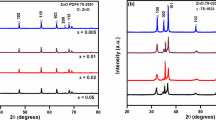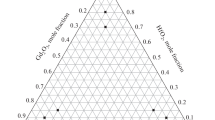Abstract
Low thermal conductivity ceramics in the ZrO2-GdO1.5 system have potential in structural (refractories, thermal barrier coatings, thermal protection) and nuclear applications. To that end, the thermal conductivities of hot-pressed xGdO1.5 ·(1 - x)ZrO2 (where x = 0.05, 0.15, 0.31, 0.50, 0.62, 0.75, 0.89, and 1.00) solid solutions were measured, for the first time, as a function of temperature in the range 25 to 700 °C. On the ZrO2-rich side, the thermal conductivity first decreased rapidly with increasing concentration of GdO1.5 and then reached a plateau. On the GdO1.5-rich side, the decrease in the thermal conductivity with increasing concentration of ZrO2 was less pronounced. The thermal conductivity was less sensitive to the composition with increasing temperature. The thermal conductivity of pyrochlore Gd2Zr2O7 (x = 0.5) was higher than that of surrounding compositions at all temperatures. A semiempirical phonon-scattering theory was used to analyze the experimental thermal conductivity data. In the case of pure ZrO2 and GdO1.5, the dependence of the thermal conductivity to the absolute temperature (T) was less than 1/T. Therefore, the minimum thermal conductivity theory was applied, which better described the temperature dependence of the thermal conductivity of pure ZrO2 and GdO1.5. In the case of solid solutions, phonon scattering by cation mass fluctuations and additional scattering by oxygen vacancies on the ZrO2-rich side and by gadolinium vacancies on the GdO1.5-side seemed to account for the composition and temperature dependence of the thermal conductivity.
Similar content being viewed by others
References
G. Suresh, G. Seenivasan, M.V. Krishnaiah, and P.S. Murti, J. Nucl. Mater. 249, 259 (1997).
N.P. Padture, M. Gell, and E.H. Jordan, Science 296, 280 (2002).
D.J.M. Bevan and E. Summerville, in Handbook on the Physics and Chemistry of Rare Earths: Non-Metallic Compounds I, edited by K.A. Gschneider and L.R. Eyring (North-Holland Physics Publishing, New York, 1979), Vol. 3, p. 412.
M.A. Subramanian and A.W. Sleight, in Handbook on the Physics and Chemistry of Rare Earths, edited by K.A. Gschneider and L. Erying (Elsevier Science Publishers, Oxford, U.K., 1993), Vol.16, p. 225.
R. Vaßen, X. Cao, F. Tietz, D. Basu, and D. Stöver, J. Am. Ceram. Soc. 83, 2023 (2000).
M.J. Maloney, U.S. Patent No. 6 117 560 (2000).
M.J. Maloney, U.S. Patent No. 6 284 323 (2001).
G. Suresh, G. Seenivasan, M.V. Krishnaiah, and P.S. Murti, J. Alloys Compd. 269, L9 (1998).
J. Wu, X. Wei, N.P. Padture, P.G. Klemens, M. Gell, E. Garcia, P. Miranzo, and M.I. Osendi, J. Am. Ceram. Soc. 85 (2002).
T.A. Ring, Fundamentals of Ceramic Powder Processing and Synthesis (Academic Publishers, New York, 1996).
K.D. Maglic, A. Cezairliyan, and V.E. Peletsky, ASTM Standards E1461-92, E1269-92 (Plenum Press, New York, 1992).
O. Kubaschewski and C.B. Alcock, Metallurgical Thermochemistry (Pergamon Press, London, U.K., 1967).
R.A. Swalin, Thermodynamics of Solids (John Wiley & Sons, New York, 1972).
P.G. Klemens, High Temp.-High Press, 23, 241 (1991).
K.W. Schlichting, N.P. Padture, and P.G. Klemens, J. Mater. Sci. 36, 3003 (2001).
S. Raghavan, H. Wang, R.B. Dinwiddie, W.D. Porter, and M.J. Mayo, Scr. Mater. 39, 1119 (1998).
S. Raghavan, H. Wang, W.D. Porter, R.B. Dinwiddie, and M.J. Mayo, Acta Mater. 49, 169 (2001).
P.G. Klemens, in Thermal Conductivity, edited by R.P. Tye (Academic Press, !London, U.K., 1969), Vol. 1, p. 1.
P.G. Klemens, in Thermal Conductivity 23, edited by K.E. Wilkes, R.B. Dinwiddie, and R.S. Graves (Technomics Publishing Co., Lancaster, PA, 1996), p. 209.
G.A. Slack, in Solid State Physics, edited by H. Ehrenreich, F. Seitz, and D. Turnbull (Academic Publishers, New York, 1979), Vol. 34, p. 1.
D.J. Green, R.H.J. Hannink, and M.V. Swain, Transformation Toughening of Ceramics (CRC Press, Boca Raton, FL, 1989).
D. Balestrieri, Y. Philipponneau, G.M. Decroix, Y. Jorand, and G. Fantozzi, J. Eur. Ceram. Soc. 18, 1073 (1998).
M.C. Roufosse and P.G. Klemen, J. Geophys. Res. 79, 703 (1974).
J. Tavernier, C. R. Acad . Sci. 245, 1705 (1957).
C.A. Ratsifaritana and P.G. Klemens, Int. J. Thermophys. 8, 737 (1987).
M. Perez-Y-Jorba, Ann. Chim. (Paris) 7, 479 (1962).
J.H. Harris, R.C. Erk, and R.A. Youngblood, Phys. Rev. B 47, 5428 (1993).
J.R. Nicholls, K.J. Lawson, A. Johnstone, and D.S. Rickerby, Surf. Coat. Technol. 151, 383 (2002).
D. Zhu and R.A. Miller, Ceram. Eng. Sci. Proc. 23, (2002, in press).
Author information
Authors and Affiliations
Corresponding author
Rights and permissions
About this article
Cite this article
Wu, J., Padture, N.P., Klemens, P.G. et al. Thermal conductivity of ceramics in the ZrO2-GdO1.5system. Journal of Materials Research 17, 3193–3200 (2002). https://doi.org/10.1557/JMR.2002.0462
Received:
Accepted:
Published:
Issue Date:
DOI: https://doi.org/10.1557/JMR.2002.0462




